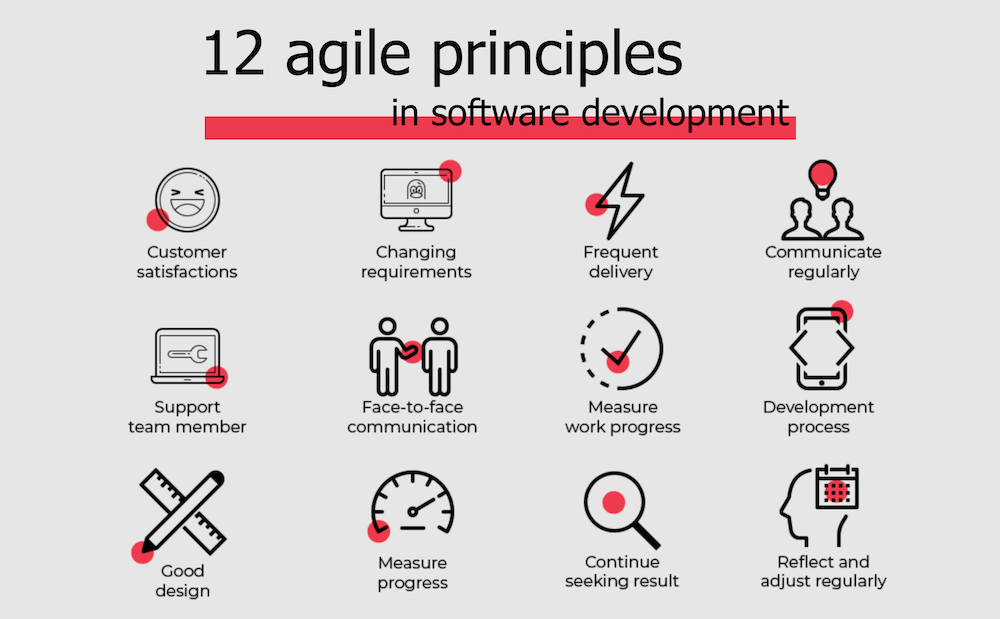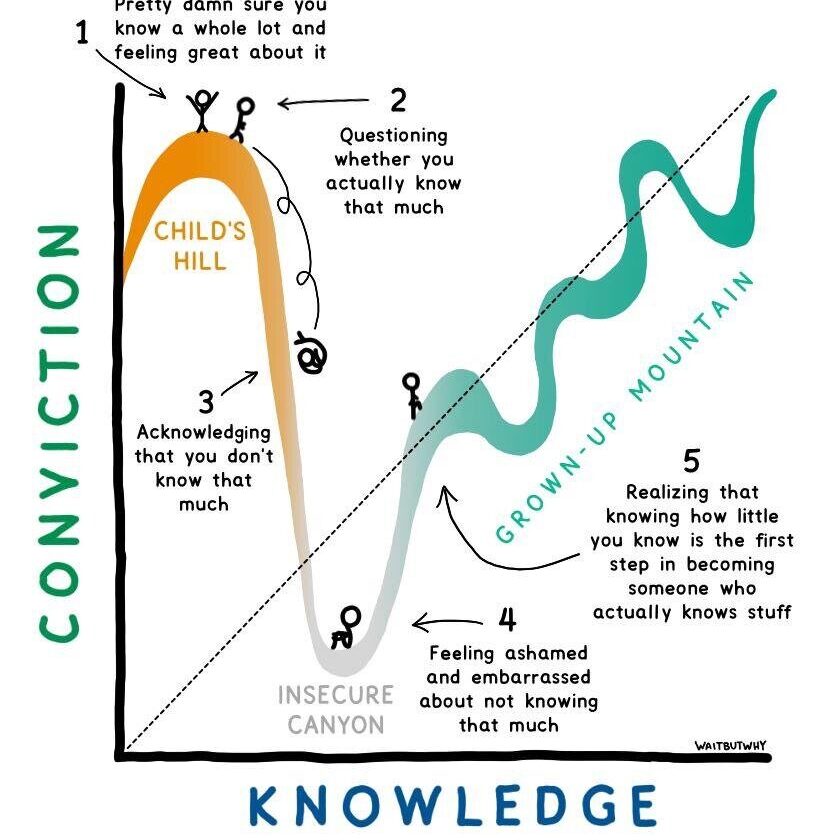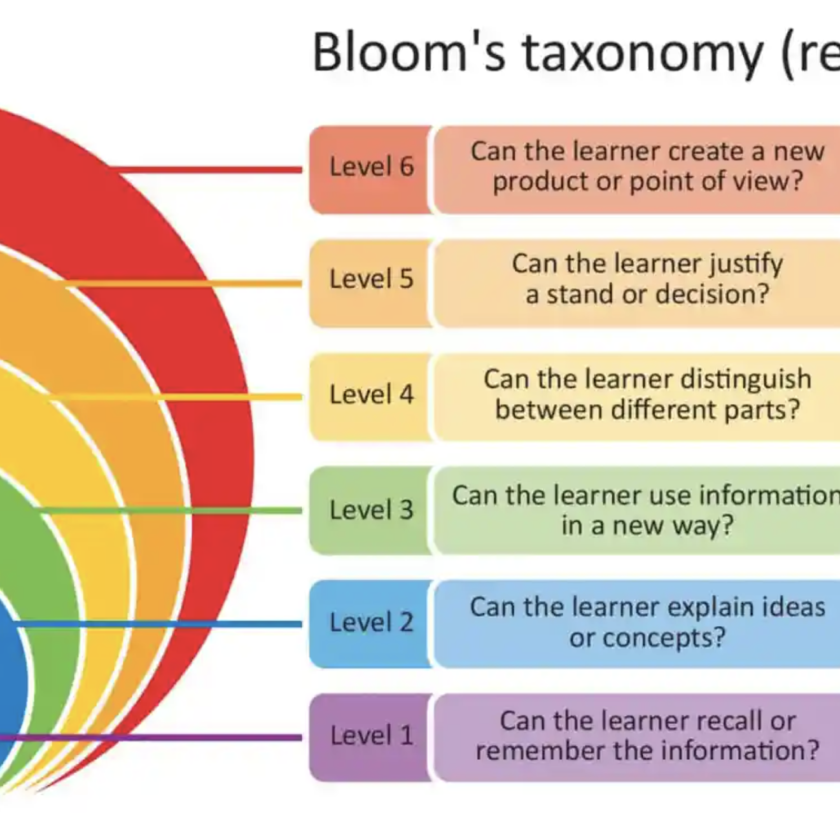Contents
- What are the Agile principles
- Principle 1: Customer satisfactions
- Principle 2: Changing requirements
- Principle 3: Frequent delivery
- Principle 4: Communicate regularly
- Principle 5: Support team member
- Principle 6: Face to face communication
- Principle 7: Measure work progress
- Principle 8: Development process
- Principle 9: Good design
- Principle 10: Measure progress
- Principle 11: Continue seeking result
- Principle 12: Reflect and adjust regularly
What are the Agile principles
12 Agile principles are a part of Agile methodology. Agile means moving and thinking fast and easily.
Based on that concept, the Agile model was introduced, especially in the software industry, to facilitate and improve project management.

Principle 1: Customer satisfactions
“Our highest priority is to satisfy the customer through early and continuous delivery of valuable software.”
To make a product quickly delivered to end-users. Agile teams often focus on creating a minimum viable product (MVP). An MVP only comes with enough core features and is often used by early real customers. They accordingly give development teams early feedback about the software for continuous improvements in the future.
So no matter whether your team wants to build an MVP or release improved features. The highest priority is always making your customers happy about the values they receive from software.
How it works in practice:
- Develop an MVP to test your paper ideas;
- Regularly release updated versions and features to constantly promote the feedback loop between end-users and products;
- Make continuous improvements based on market trends and customer responses.
Principle 2: Changing requirements
“Welcome changing requirements, even late in development. Agile processes harness change for the customer’s competitive advantage.”
In some industries like IT, the market and customer demands are usually changing. Accordingly, a product that is developed with well-documented plans doesn’t always meet changeable needs. Therefore, agile comes into play to help resolve such a problem.
Particularly, agile processes enable product teams to respond to changing market trends, user demands, and even competitive threats with ease. Teams then can review, analyze and add new findings when necessary to build a more satisfying and competitive product.
How it works in practice:
- Agile teams don’t work based on a predetermined set of features, but rather high-level strategic objectives. These goals support them to build coherent products that respond well to market changes.
- Changes in market and customer needs are among the main drivers behind product improvements. Agile teams frequently modify plans sensibly to best serve such demands.
- Also, those adjusted strategies also need to suit business requirements and expectations. So product owners and other stakeholders should understand well why changes in products are essential.
Principle 3: Frequent delivery
“Deliver working software frequently, from a couple of weeks to a couple of months, with a preference to the shorter timescale.”
Agile allows development teams to shorten the time from ideating to releasing a product. To do so, agile teams repetitively conduct, deploy and modify a product’s functionality in short cycles. In other words, instead of building the entire software. Agile teams focus on creating and shipping some small parts of the software.
This property helps set agile apart from traditional approaches which come with long development phases. Further, it gives your team more avenues to continuously validate hypotheses and ideas.
How it works in practice:
- Teams break software development activities down into smaller pieces. They will complete such activities that are completed in a short timeframe called “iteration”. An iteration typically lasts two weeks. But in reality, it still depends on the project’s complexity and size as well as your team’s velocity.
Principle 4: Communicate regularly
Business people and developers must work together daily throughout the project.”
The agile model requires frequent interactions between a client (commonly known as “a product owner”) and developers.
As small chunks of work are conducted in short-term cycles and changes can be made, the presence of business representatives is necessary. This is because a successful product needs examining not only from technical aspects but also from business insights.
Therefore, frequent communication between product owners and development teams prevents misunderstanding and builds transparency and trust. Also, working together throughout the project helps ensure work progress and a product’s quality.
How it works in practice:
- Besides those taking over development tasks, a multidisciplinary agile team also includes a product owner and other stakeholders who cover business aspects.
- Regular meetings are held to keep people constantly involved in product development and update procedures.
Principle 5: Support team member
“Build projects around motivated individuals. Give them the environment and support they need, and trust them to get the job done.”
Agile itself has cons. Many companies, however, tackle its drawbacks and still succeed in creating the desired software by building a strong core team.
Accordingly, an agile team needs motivated individuals who have decent leadership skills and proper expertise to do jobs well. Also, team members should be given autonomy, a reliable working environment, and obviously defined responsibilities before projects start.
How it works in practice:
- A product owner needs to explain requirements and devise a clear roadmap for a development team to understand.
- Meanwhile, development team members interpret how to build a product’s components. Particularly, they are in charge of developing UX/UI design and backend.
Principle 6: Face to face communication
“The most efficient and effective method of conveying information to and within a development team is face-to-face conversation.”
There’s a wide argument that face-to-face meetings are the best way to exchange information. Although this statement holds true to some extent, it’s not always possible for product owners and developers to meet in person. Especially today, many companies tend to use offshore outsourcing services. So most conversations now take place online (typically video conferencing).
Regardless of communication channels, the key meaning behind this principle is always motivating members to interact about software, strategies, and requirements in real-time.
How it looks in practice:
- Daily stand-up meetings;
- Iteration planning meetings;
- Frequent backlog grooming;
- Pair-programming sessions;
- Regular demos.
Principle 7: Measure work progress
“Working software is the primary measure of progress.”
There’s perfect software, as the market is always changing and customers often alter their demands. Therefore, instead of depending on detailed plans and documents to build a so-called perfect product, you should focus on a working one.
The working software doesn’t only operate on your expected platforms and devices but also meet user and business requirements. Teams often release updated features to provide customers with useful values.
How it works in practice:
- Development teams prioritize the development of minimum viable components for an MVP to get quick feedback from the first real customers.
- Teams apply the fail-fast technique to experiment with ideas quickly while trying to achieve expected outcomes.
- Teams try to build a useful product rather than a perfect one by frequently shipping new releases.
Principle 8: Development process
“Agile processes promote sustainable development. The sponsors, developers, and users should be able to maintain a constant pace indefinitely.”
As said before, agile processes enable product teams to build and deploy new features continuously. This encourages a product’s sustainable development.
However, updating versions too often and too rapidly may exhaust team members, especially if they set too high goals. To avoid exhaustion and turnover, a cross-functional team should establish realistic expectations, learn to stay enthusiastic, and enhance work/life balance.
How it looks in practice:
- Team members determine how much work needs to be done before each iteration. The workload depends on the capacity and velocity of developers as well as a timeframe. So they should not exaggerate what they hardly do.
- Agile teams should identify which tasks to do during each iteration. No responsibility is added if cases are irresistible.
- A product owner should create an atmosphere of mutual trust with developers that allows free feedback and open communication.
- A product manager or a Scrum master should function as a mediator. He/She needs to avoid unplanned activities over an iteration and curb the superfluous intervention of a product owner in technical jobs.
Principle 9: Good design
“Continuous attention to technical excellence and good design enhances agility.”
As we’re talking about building software, its technical components and design are what you should care about. During the agile development process, frequent releases and updates are encouraged but with consideration. In other words, agile teams should attend to developing intuitive interfaces and free-bug codes to avoid unexpected troubles induced by poor technical performance.
How it works in practice:
- Agile teams distribute development resources to code refactoring. This technique helps modify the software’s internal structure but does not affect its functional attributes.
- Technical debt is the hidden cost of leaving some functionality for later development to focus on speedy delivery instead. A product owner and developers should discuss the software’s tech debt impacts to grasp when or whether such costs are acceptable.
Principle 10: Measure progress
“Simplicity–the art of maximizing the amount of work not done–is essential.”
For rapid shipping, the agile approach highlights the importance of simplifying the first version of a product.
Simplicity here means minimizing the amount of work done but still achieving the most optimal results. Like the Pareto principle, 80% of a team’s desired outcomes come from 20% of development work.
Accordingly, team members need to work on the most influential features that prioritize solving the pain points of users and reaching organizational goals. Building an entire complicated product also proves redundant during the agile development process.
How it works in practice:
- A product manager uses agile prioritization models to carefully pick which features or user stories should be included in the software. Also, such attributes and development strategies need to be closely aligned with business goals.
- Short iterations of agile allow your team to experiment and validate your ideas quickly. This accordingly helps discover good initiatives and filter out bad ones.
Principle 11: Continue seeking result
“The best architectures, requirements, and designs emerge from self-organizing teams.”
The agile methodology is closely linked to the key principle of encouraging individuals to work together in a “flat” working environment. It’s where team members contribute opinions and then a whole team finalizes decisions rather than a managerial individual. This concept helps boost a group’s communication and values over the software development procedure. Besides, a self-organizing team can create the best designs and functionality for a product.
How it works in practice:
- Different companies build self-organizing teams in different ways to carry out respective projects. These groups are given autonomy to take over the right responsibilities. Then control the whole process and make product-driven decisions.
Principle 12: Reflect and adjust regularly
“At regular intervals, the team reflects on how to become more effective, then tunes and adjusts its behavior accordingly.”
The agile model ties to the idea of continuous improvements. This concept is not only about the way you release new updates to reflect on the changing market and improve the software. But it also extends to development procedures and teams. In other words, your team should learn to become more productive and enhance processes.
How it works in practice:
- Your team needs to revise and test not only products but also the development process and working style. Evaluating and adjusting the development method is essential to ensure it supports software-building activities effectively.
- Frequent retrospectives are occasions for your team to discuss what was done well in a previous phase and what needs to be improved in upcoming phases. It helps reflect on how parties communicate and whether developers were given what they need to complete tasks well. Accordingly, all parties can adjust their working strategies and behaviors to work more effectively next time.






